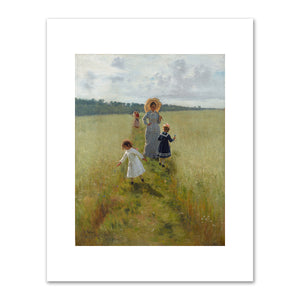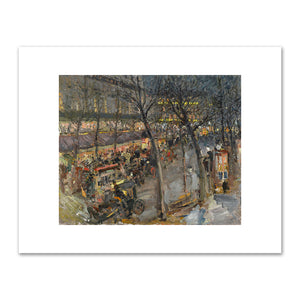Collection: Impressionism in Russia: Dawn of the Avant-Garde
As the leading European metropolis of art, Paris attracted painters from the academies of Moscow and St. Petersburg since the 1860s. Through their examination of the Impressionist style of painting modern life, they liberated themselves from the academic rules that governed Realist painting in Russia. Interaction with French painting inspired artists such as Ilia Repin, Konstantin Korovin, and Valentin Serov to produce works that in addition to the impression of the present moment also showed a sensory world that confronted modern life. Electric lights, shop window displays, and the architecture of the modern boulevards offered them motifs that they treated with great painterly freedom.
The practice of painting outdoors that was inspired by the Impressionists transformed Russian art and made landscapes popular. Repin, Vasily Polenov, and their pupils Korovin and Serov explored nature around Moscow and traveled to the expanses of the north. Painting en plein air and a sketch-like style led artists to motifs that expressed a zest for life, encouraging a shift away from the existential subjects of Russian art. Artists captured the carefreeness of modern recreational activities in Impressionist interiors that are suffused with light. Studies of light effects in indoor scenes and in still lifes led to a new appreciation of these genres that were little esteemed at the academy in Moscow. In portraits and pictures of families, Russian artists linked candor with psychological depth to create their own style of Impressionism. Questions of national identity were just as important as the relationship to the tradition of Realism in painting. Impressionism, with its focus on spontaneous expression and modernity that transcended borders, gave new impulses for dealing with this.
The practice of painting outdoors that was inspired by the Impressionists transformed Russian art and made landscapes popular. Repin, Vasily Polenov, and their pupils Korovin and Serov explored nature around Moscow and traveled to the expanses of the north. Painting en plein air and a sketch-like style led artists to motifs that expressed a zest for life, encouraging a shift away from the existential subjects of Russian art. Artists captured the carefreeness of modern recreational activities in Impressionist interiors that are suffused with light. Studies of light effects in indoor scenes and in still lifes led to a new appreciation of these genres that were little esteemed at the academy in Moscow. In portraits and pictures of families, Russian artists linked candor with psychological depth to create their own style of Impressionism. Questions of national identity were just as important as the relationship to the tradition of Realism in painting. Impressionism, with its focus on spontaneous expression and modernity that transcended borders, gave new impulses for dealing with this.
Along the Field Boundary: Vera Repina Is Walking along the Boundary with Her Children by Ilja Repin


- Regular price
- from €19,95 to €103,95
- Sale price
- €103,95
Paris: Café de la Paix by Konstantin Korovin


- Regular price
- from €19,95 to €103,95
- Sale price
- €103,95



